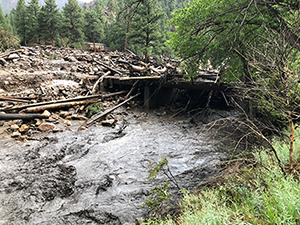When fires destroy a community’s watershed, the main source of water supply, many cities would be hard-pressed to clean up their supply without disruption. But Greeley has several different sources from which to draw its drinking water, and it has built great relationships with other water providers to work together in difficult times.
The Cameron Peak fire, which scorched more than 208,000 acres, may have become the largest wildfire in the state in 2020, but the aftermath continues to be a concern a year later. The summer monsoon rains wash ash, sediment and fire debris into the river, so it takes regional cooperation to help clean up and rehab burned areas, and limit erosion to ensure continuous water quality.
When one, or even many water sources  become cloudy and black with ash, sediment and debris from forest fires, Greeley has cost-effective water resources and treatment options. The diversity in supply and treatment infrastructure allows Greeley staff to navigate around poor water quality without affecting taste or quality or disrupting service. Greeley’s Water and Sewer Board has worked for years to ensure such a system in which the city has several options in times of need.
become cloudy and black with ash, sediment and debris from forest fires, Greeley has cost-effective water resources and treatment options. The diversity in supply and treatment infrastructure allows Greeley staff to navigate around poor water quality without affecting taste or quality or disrupting service. Greeley’s Water and Sewer Board has worked for years to ensure such a system in which the city has several options in times of need.
Due to the board’s planning, Greeley draws its drinking water from multiple sources -- the Cache la Poudre and Laramie River basins, which are treated at the Bellvue Treatment plant north of Fort Collins, the Big Thompson Basin, treated at the Boyd Lake Treatment plant in Loveland, and Colorado-Big Thompson project water from the Colorado River, is treated at both plants.
Greeley’s water history is extensive and so are the city’s relationships with other water providers. In the case of cleaning up from the Cameron Peak Fire, the city has so far had to pass on 400 acre-feet of bad water from the Poudre River because of the high amounts of ash and debris within it. That’s enough water to supply from 133-200 households for an entire year.
However, Greeley water leaders leveraged their relationship with the North Poudre Irrigation Company (NPIC) to trade water. The deal has thus far provided Greeley 400 acre-feet of water the NPIC had stored in Horsetooth Reservoir west of Fort Collins. In exchange, Greeley sent the same amount of Poudre River direct flow water to NPIC. This allows Greeley to avoid water quality impacts and NPIC to receive the water they need for irrigation. Greeley may have to continue these types of trades for many years while the forest rebuilds itself.
Greeley has significant resources to meet our needs today and well into the future – and the diversity of water sources adds reliability and reduces risks from droughts and wildfires. For that reason, Greeley will continue to build relationships to ensure our water remains safe and reliable for its citizenry.